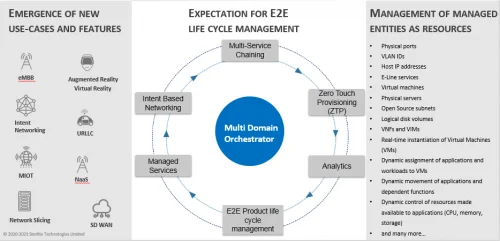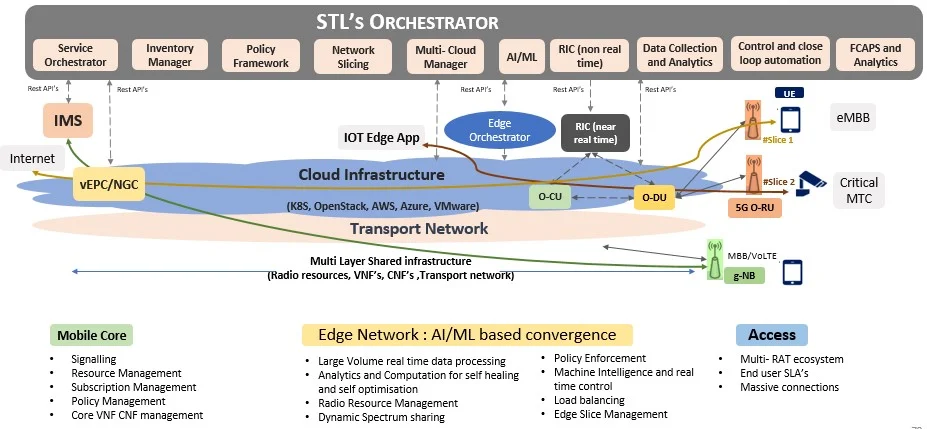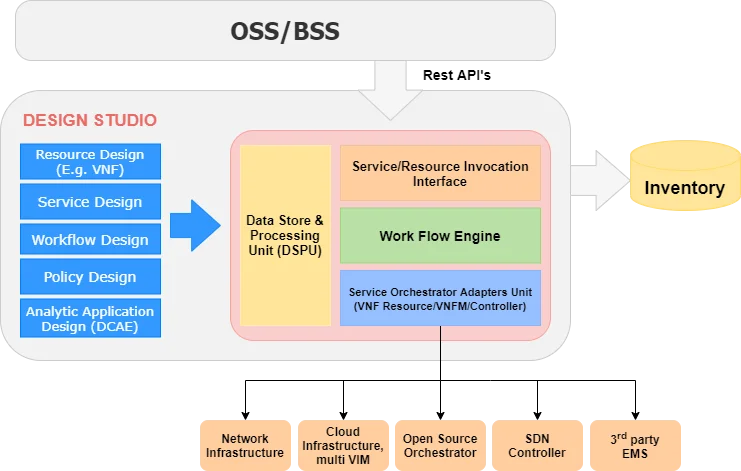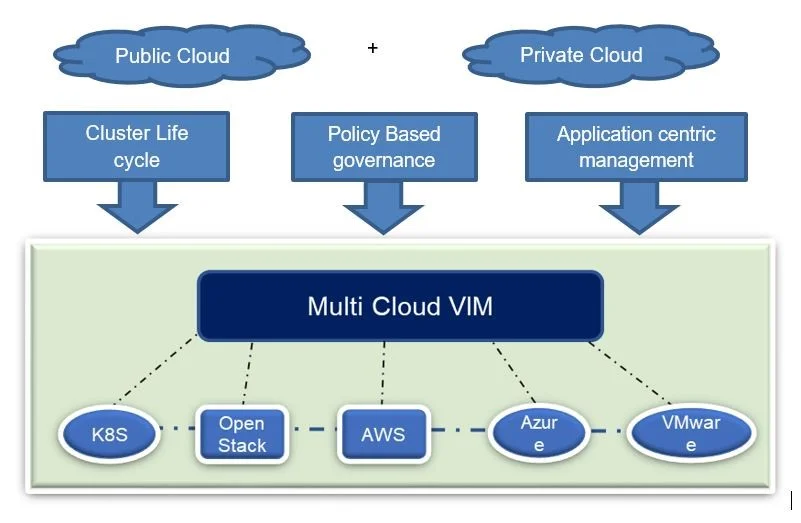We discuss the following topics in this blog:
- Business Drivers for Network Orchestration
- STL’s Network Orchestration Platform
- Key Modules of Network Orchestrator
- Key Features of Network Orchestrator
- Network Slicing as a Use Case of Network Orchestrator
In addition to these topics, we shall also be answering the following FAQs:
- What is WiFi?
- What is an Optical Fibre Cable?
Contents
Overview
Network orchestration is a way of bringing automation and virtualization to the network functions and services. This helps service providers in delivering secure and quick services to their customers while making their business models more agile and efficient.
Today the way we look at telecommunication networks is quite different from the way we have seen in past decades. Networks are evolving, becoming dynamic entities, and more open every day. As these network transformations occur on a global scale, service providers need an integrated Orchestrator to gain greater control, cost efficiencies, visibility, automate key network functions, and deliver top-notch customer services and experiences.
In a typical virtual network, all the functions are defined, designed, and engineered by virtual network functions (VNFs). To add intelligence and automation to these VNFs, an orchestrator is required to enable features like FCAPS, analytics, automated workflows, scaling, healing, and zero-touch provisioning (ZTP).
Business Drivers for Network Orchestration or Why Network Orchestration?
The emergence of new use cases- eMBB, AR/VR, rise in the IoT enabled use cases such as Industry 4.0 applications, V2X, M2M, Online gaming, online content streaming has made operators rethink their network architecture strategy. The new architecture requires storage, computation, and analytics closer to the edge of the network to deliver these use cases and provide premium quality of experience (QoE) to the end consumer.
Additionally, a new network with a mix of 4G and 5G radio access and virtual & disaggregated deployment of CU-DU and core is expected to deliver significantly exceptional operational performance (e.g. dynamic spectrum sharing, load balancing, wide area optimization, etc.) as well as superior user experience (with KPI’s near to fixed network offering full mobility and coverage).

STL’s Network Orchestration Platform:
STL’s network orchestration platform is envisaged as an application management system that provides building blocks that include micro-services architecture, model-driven templates, and multi-domain design scope.
As shown below, STL’s cloud-native architecture consists of Orchestrator at the centralized location for service orchestration, cloud infrastructure, and service assurance management coupled with Edge Orchestrator, Open and disaggregated CU-DU architecture, and RAN Intelligent controller (RIC) allows greater flexibility in delivering the quality of experience (QoE) for B2C and B2B customers.

The micro-services-based orchestrator includes smaller, independent services that communicate with each other using REST APIs (Representational State Transfer Application Program Interfaces). Each micro-service function is responsible for a specific task, thus facilitating a modular approach to system building. The platform developed with Kubernetes as the docker container orchestration provides autonomous, distributed application micro-services. These containers allow us to scale and deploy easily across the network, as well as control them with standard or custom configurations.
STL orchestrator at the central layer with network slicing, multi-domain life cycle management, cloud infrastructure management, and close loop automation capabilities helps the service providers to addresses their challenges for zero-touch automation, centralized network management, and multi-layer discovery and visualization across multiple domains. STL Orchestrator open to integrating multi-vendor with open-APIs simplifies O&M by automatically optimizing network-wide service resources and policies based on multi-layer traffic information.
What are the Key Modules of Network Orchestrator?
- Service Orchestrator:
Network Function Virtualization (NFV) enables service providers to quickly scale and deploy network services. Each network service can contain multiple interconnected network functions, in a virtualized manner on standardized hardware platforms. Along with these, there are requirements to design and introduce new network services, activate and terminate these network services within the network, manage their elastic scaling at run-time, and optimize their use of the underlying infrastructure with high performance and reliability. Further, it is also expected to manage the E2E lifecycle of complex virtual network functions (VNFs) and services running on a multi-vendor underline ecosystem.
STL’s Service Orchestration solution fulfills the above requirements and considerably expands upon the role of the NFV Orchestrator as defined by the European Telecommunications Standards Institute (ETSI) NFV Industry Standards Group and Service Orchestrator as defined by ONAP as well as it also emphasis on Open Digital Architecture framework as defined by TMF making it true open platform.
As shown in the above diagram, STL’s Service Orchestration solution enables service providers to:
- Reinforce TOSCA models in native format as distributed by SDC
- Perform lifecycle operations based on a declarative TOSCA model, including:
- Deployment
- Scale (Out, In)
- Heal
- Software upgrade
- Deactivation
- Compose and rapidly onboard network service spanning multiple VNFs in multi-vendor network environments
- Design and instantiate network services and their constituent, interconnected VNFs such as L3VPN, Manage network service, and VNF scaling
- Integrate with complementary OSS and SDN controllers using RESTful APIs for automated operation
- Handle the VNF lifecycles in coordination with VNF Managers (VNFMs)
2. Slice Manager:
Network slicing, which is the critical aspect of 5G, enables the support of diverse 5G services over a shared multi-vendor network infrastructure. The objective of 5G wireless technology is to support three generic services: enhanced mobile broadband (eMBB), massive machine-type communications (mMTCs), and ultra-reliable low-latency communications (URLLCs).
STL 5G Slice Manager helps service providers through automated and streamlined management of innovative services that are based on 5G network slicing which helps service providers to maximize the monetization of 5G networks. STL’s solution dynamically selects and allocates underlying physical and cloud resources, and views the live status data and event-driven updates via a close loop automation platform.

STL 5G Slice Manager includes three major functionalities for slice design, instantiation and performance management:
• Slice Design: It links various network functions and connection points to create specific network slice services to strengthen slice modelling
• Slice Orchestration: This represents network slices and the associated network functions by interacting with the different domain controllers to configure all the resources required to create network slices and ensure a link between represented slice resources and the end-to-end designed slice.
• Network Slice Lifecycle Management
STL’s 5G Slice Manager is responsible for network slice lifecycle management and is hierarchically positioned at the top of the network management architecture to coordinate multi-domain infrastructure (the RAN, Transport and Core network) slice subnet operations and services.
3. Multi-Cloud Manager:
To leverage the benefits of cloud technologies, there is a growing shift towards the deployment of cloud infrastructure in all segments of networks. The operators are doing this by creating their own private cloud platform where they expect all the next-generation applications can be deployed and managed from it. Additionally, the usage of the public cloud is rising due to growing demands from enterprise customers. The multi-cloud management solution for management and orchestration of public and private clouds enables operators to take advantage of the innovations in analytics, artificial intelligence, machine learning, and cloud that can directly impact their profitability and business model.
STL Multi-Cloud manager aims to mediate most interactions between Service Orchestrator and any underlying VIM or Cloud to:
• Enable Service and Infrastructure Orchestrator to deploy and run on multiple infrastructure environments on any public or private cloud.
• Provide a Cloud Mediation Layer supporting multiple infrastructures and network backend so as to effectively prevent vendor lock-in.
• Decouples the evolution of the Service Orchestrator platform from the evolution of underlying cloud infrastructure, and minimizes the impact on the deployed Service Orchestrator.

Multi-cloud environments can enable flexibility to fuel up innovation, optimising cost, and providing a stable production environment. They have an option to innovate with new technologies like AI on public clouds, deploy a private cloud, or tap into infrastructure as a service to develop new applications on demand.
What are the Key Features of Network Orchestrator?
- Standardized and disaggregated design: STL follows standardized configuration modelling language for the data modelling across services, resources and infrastructure domains. It helps in the deployment of VNFs by enabling containerization, service creation, and nested services scenarios.
- Multi-level orchestration: It enables VNFs across multi-level domains including global data centre, regional data centre and edge cloud locations. This enables us to implement use cases for distributed analytics requirements across different levels.
- Supports heterogeneous cloud regions: This orchestration platform provides support for heterogeneous cloud regions i.e. OpenStack and Kubernetes.
- Strong policy-driven orchestration: It supports dynamic configuration management through a centralized policy management framework. It also provides support for a closed control loop through ONAP’s CLAMP/Policy/SDC.
- Centralized logging and monitoring: This platform gives a single view of deployed services and their relationships. Policies will be triggered for healing and scaling by analytic services, based on the data collected in the VES collector.
- Built-in cloud-native support: It supports Kubernetes infrastructure management like VNF packaging in helm charts, multi-tenancy, multi-cluster application scheduler, service mesh controller, CA key distribution controller, multi-networking configuration support controller, and cloud distribution service manager.
- ML deployment: It supports the deployment of trained ML Models in dockerized containers within its analytics platform.
Network Slicing as a Use Case of Network Orchestrator
For some of the specific services, there is a need to create a separate network slice to meet their stringent SLAs. STL orchestrator creates various logically independent network slices to support specific services and manages them dynamically.
In order to manage the lifecycle of the network functions along with provisioning services and providing closed-loop control— STL has developed a model-driven orchestrator which will be able to perform the below functions:
- Map the service-related requirements to the slice related requirements
- Orchestrate and manage slicing at resource, network slice instance and service layer
- Manage the various lifecycles of the slice— preparation, instantiation, configuration, activation, runtime and decommissioning
- Its model-driven templates will be used to create independent slices within the network by dynamically placing the network functions in such a way that they can match the services requirements
- Enable closed-loop control along with hybrid infrastructure management to orchestrate and manage both physical well as virtual resources used in the slice creation
As the industry is striding towards open and virtualized converged network, network orchestration will play a big role in automating the network functions and hence improving the overall spectral efficiency
FAQs
What is WiFi?
Put simply, WiFi is a technology that uses radio waves to create a wireless network through which devices like mobile phones, computers, printers, etc., connect to the internet. A wireless router is needed to establish a WiFi hotspot that people in its vicinity may use to access internet services. You’re sure to have encountered such a WiFi hotspot in houses, offices, restaurants, etc.
To get a little more technical, WiFi works by enabling a Wireless Local Area Network or WLAN that allows devices connected to it to exchange signals with the internet via a router. The frequencies of these signals are either 2.4 GHz or 5 GHz bandwidths. These frequencies are much higher than those transmitted to or by radios, mobile phones, and televisions since WiFi signals need to carry significantly higher amounts of data. The networking standards are variants of 802.11, of which there are several (802.11a, 802.11b, 801.11g, etc.).
What is an Optical Fibre Cable?
An optical fibre cable is a cable type that has a few to hundreds of optical fibres bundled together within a protective plastic coating. They help carry digital data in the form of light pulses across large distances at faster speeds. For this, they need to be installed or deployed either underground or aerially. Standalone fibres cannot be buried or hanged so fibres are bunched together as cables for the transmission of data. This is done to protect the fibre from stress, moisture, temperature changes and other externalities.
There are three main components of a optical fibre cable, core (It carries the light and is made of pure silicon dioxide (SiO2) with dopants such as germania, phosphorous pentoxide, or alumina to raise the refractive index; Typical glass cores range from as small as 3.7um up to 200um), Cladding (Cladding surrounds the core and has a lower refractive index than the core, it is also made from the same material as the core; 1% refractive index difference is maintained between the core and cladding; Two commonly used diameters are 125µm and 140µm) and Coating (Protective layer that absorbs shocks, physical damage and moisture; The outside diameter of the coating is typically either 250µm or 500µm; Commonly used material for coatings are acrylate,Silicone, carbon, and polyimide).
An optical fibre cable is made up of the following components: Optical fibres – ranging from one to many. Buffer tubes (with different settings), for protection and cushioning of the fibre. Water protection in the tubes – wet or dry. A central strength member (CSM) is the backbone of all cables. Armoured tapes for stranding to bunch the buffer tubes and strength members together. Sheathing or final covering to provide further protection.
The five main reasons that make this technology innovation disruptive are fast communication speed, infinite bandwidth & capacity, low interference, high tensile strength and secure communication. The major usescases of optical fibre cables include intenet connectivity, computer networking, surgery & dentistry, automotive industry, telephony, lighting & decorations, mechanical inspections, cable television, military applications and space.













